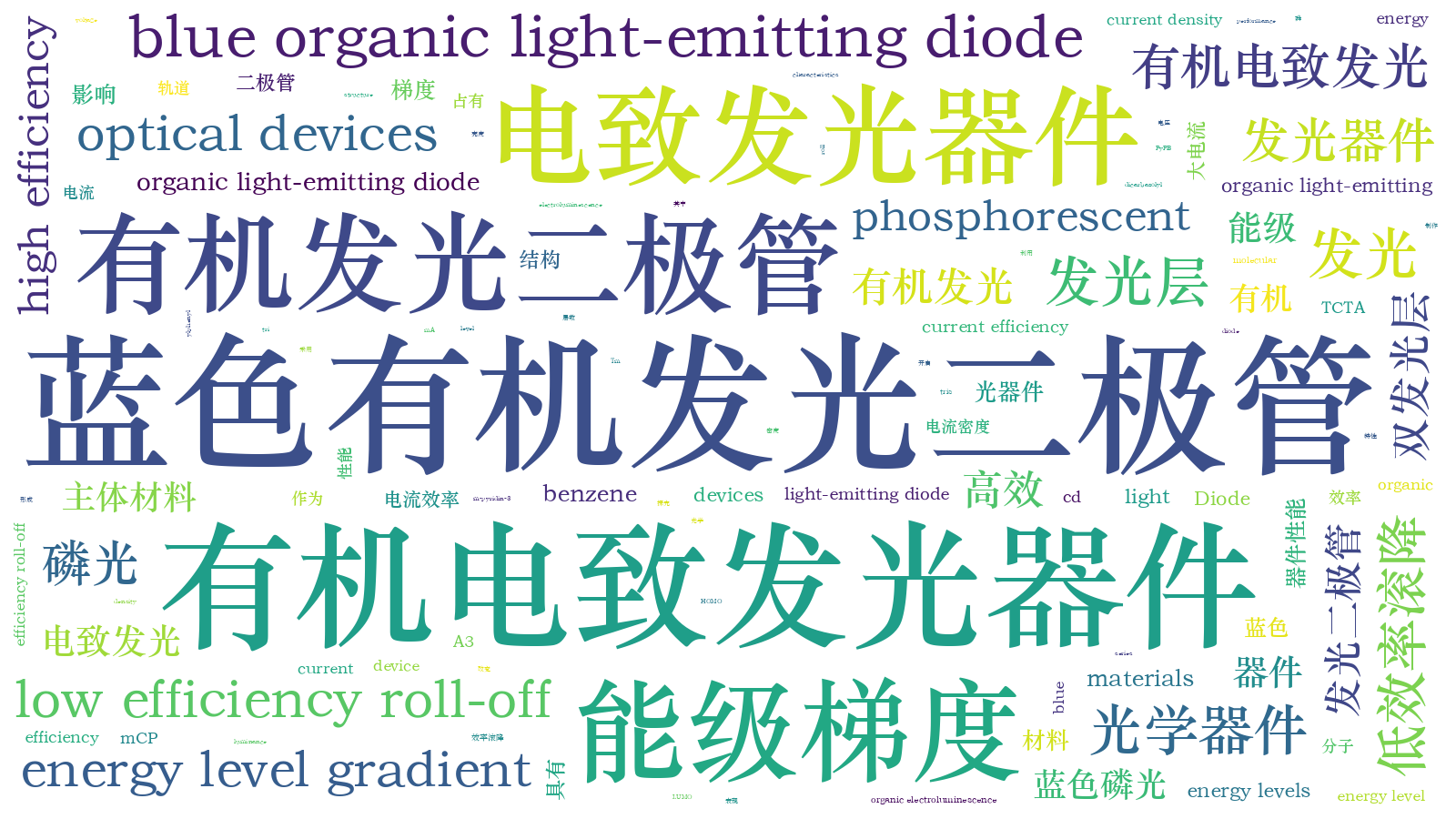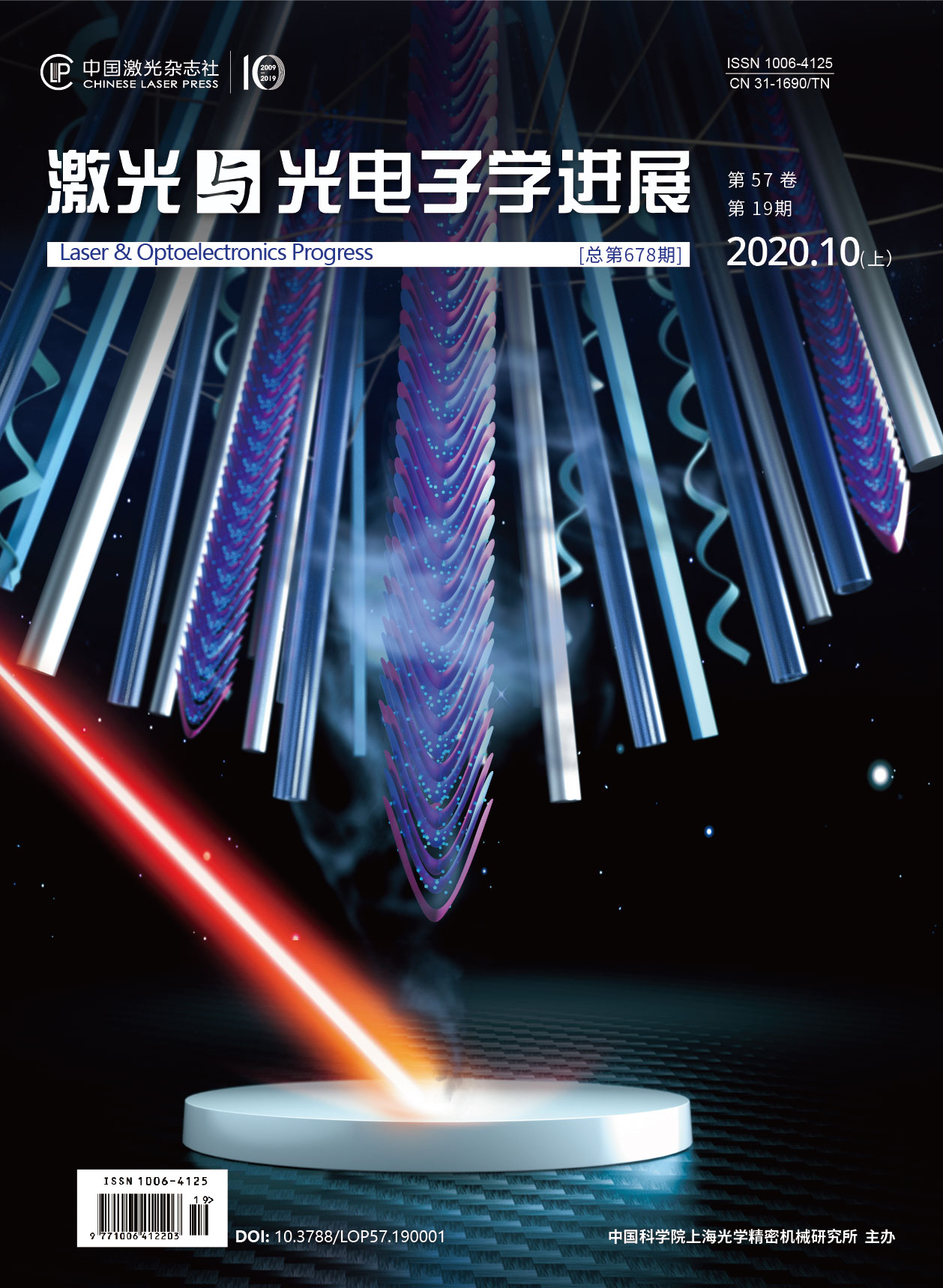发光层中能级梯度对蓝色有机发光二极管的影响  下载: 850次
下载: 850次
1 引言
自从1987年邓青云等首次利用有机材料制出双层结构的有机发光二极管(OLED)以来[1],其低工作电压和高亮度的特性吸引了全球的目光。同时,OLED制作成本低廉,工艺简单,环保无污染,还可实现柔性显示,具有非常良好的应用前景[2-6]。在过去的几年中,利用绿色和红色磷光有机发光二极管(PHOLED)已研制出高亮度、性能优良的器件,并在工业中得到应用[7-9]。虽然磷光材料不仅可以收获单重态激子,而且可以收获三重态激子,内量子效率理论上可以达到100%[10],但是蓝色PHOLED的色纯度、效率和稳定性仍需要提升才能在商业市场上实现更广泛的应用[11-12]。蓝色OLED是实现白光照明的基础,对白光OLED显色指数(CRI)的提高也有重要影响[13]。很多研究者对器件的结构进行改进,尝试用多发光层结构[14-17]、间隔层结构[18-21]和超薄层结构[22-24]来提升蓝光OLED的性能。由于多发光层结构可以对载流子和激子产生局域效应,因此它的电致发光效率比单发光层结构器件更高,亮度也更高[14-15]。Lee等[25]通过使用新型主体材料制作出多发光层结构的蓝光OLED器件,其最大亮度和电流效率达到5706 cd/m2和23.02 cd/A。Wang等[26]采用新型热激发延迟荧光材料(4-(3,3″,6,6″-tetra-tert-butyl-9'H-[9,3':6',9″-tercarbazol]-9'-yl)phenyl)phosphineoxide (TPPOCz)作为蓝色掺杂剂的主体材料,制得高效率、低滚降的蓝色OLED,其最大亮度与电流效率分别达到13235 cd/m2和43.6 cd/A,但是器件开启电压(Vturn-on,即亮度为1 cd/m2时的电压)较大。
为了获得低开启电压、高效率的蓝光OLED器件,本文使用N,N'-dicarbazolyl-3,5-benzene (mCP)、4,4',4″-tris(N-carbazolyl)triphenyl-amine (TCTA)和1,3,5-tri(m-pyridin-3-ylphenyl) benzene (TmPyPB)作为主体材料,制备了一系列具有多发光层结构的蓝光OLED器件。由于3种主体材料分别具有不同的最高占有分子轨道(HOMO)能级和最低未占有分子轨道(LUMO)能级,通过改变发光层中的主体材料和发光层的数量可以形成不同能级梯度的器件结构。优化能级梯度可以有效实现发光层中载流子传输平衡和激子局域。在分别以TCTA和mCP为主体材料的双发光层器件中,获得了低开启电压、高效率的稳定蓝光发射。
2 样品的制备与测量
实验中所使用的衬底为镀有氧化铟锡(ITO)薄膜的玻璃基板,基板表面方块电阻为15 Ω/sq。实验前将玻璃基板在乙醇溶液中浸泡0.5~1 h;然后用清洗剂、去离子水、丙酮、乙醇依次对其超声清洗15 min,再进行烘干处理。在使用真空蒸镀法进行蒸镀时保持腔内压强小于5×10-5 Pa,在蒸镀过程中有机材料蒸镀速率为0.01~0.1 nm/s。根据主客体掺杂比例调节主体和客体材料的蒸发速率,阴极金属(Al)的蒸发速率为0.2 nm/s。利用石英晶体振荡器监测蒸发速率和材料的生长厚度,器件发光区的面积为3 mm × 3 mm。器件制作结束后,用Keithley 2400数字电源和PR655光谱仪对器件进行测试,得到亮度、电流密度、驱动电压、色坐标、电致发光光谱等数据。
本实验中使用iridium(III)bis-(4,6-difluorophenyl-pyridinato-N,C2)-picolinate(FIrpic)作为蓝光客体材料;TCTA、mCP 和 TmPyPB 作为发光层主体材料,1,1'-bis((di-4-tolylamino) phenyl)cyclohexane (TAPC) 为空穴传输层(HTL)与电子阻挡层(EBL),TmPyPB作为电子传输层(ETL)和空穴阻挡层(HBL)。另外,TAPC和TmPyPB也是激子阻挡层,这是因为它们的三重态能级高于FIrpic的三重态能级(2.65 eV),分别为2.87 eV和2.78 eV[16,27]。将1,4,5,8,9,11-hexaazatriphenylene-hexanitrile (HAT-CN)作为空穴注入层,8-hydroxyquinolinolato lithium (Liq)作为电子注入层。通过改变相邻发光层中主体材料形成能级梯度结构。材料的能级[16,28]和发光层结构如
3 分析与讨论
如

图 1. 器件A1~A4的EML结构与能级示意图
Fig. 1. Schematic of the EML structures in devices A1--A4 and energy level diagram of materials
器件A1~A4 的电光特性及相应的参数如
表 1. 不同结构器件的电致发光特性
Table 1. Electroluminescence characteristics of devices with different structures
| ||||||||||||||||||||||||||||||||||||||||||

图 2. 器件A1~A4 的电光特性。 (a)亮度与电流密度随电压的变化曲线; (b)功率效率与电流效率随电流密度变化曲线
Fig. 2. Electro-optical characteristics of devices A1--A4. (a) Curves of luminance and current density changed with voltage; (b) curves of power efficiency and current efficiency changed with current density
器件A2和器件A3都属于双发光层器件。由于双发光层器件有助于扩展复合区并形成激子局域效应,从而提高效率,因此相比于器件A1,器件A3的最大功率效率和最大电流效率都得到了提高,分别达到了33.75 lm/W和40.28 cd/A。如
器件A4采用了三发光层的器件结构。三发光层器件结构可以形成更加平缓的能级梯度结构,这有利于载流子的传输,从而提高电流密度。虽然器件A4的最大电流密度远大于器件A1,但是TmPyPB对空穴电流的阻挡效果和发光层数量增加而产生的界面效应共同作用,导致器件A4的最大电流密度只有109.97 mA/cm2。与具有单发光层结构的A1器件相比,发光层数量的增加虽然有利于进一步局域载流子和激子,但是TmPyPB作为其中一个发光层的主体材料,使得复合区位置发生变化,从发光层与电子传输层交界处移至两个子发光层(mCP和TmPyPB为主体材料的两个发光层)的交界处,缩小了复合区的范围,导致局域过度,从而引起激子淬灭。因此,器件A4的最大功率效率虽然得到进一步提高,达到了29.98 lm/W,但是电流效率(E)反而下降为38.17 cd/A。如

图 3. 器件A1~A4电流效率随电流密度的变化曲线
Fig. 3. Curves of current efficiency changed with current density in devices A1--A4

图 4. 器件A1~A4在电压为8 V时的电致发光光谱图和色坐标。插图为点亮的OLED器件
Fig. 4. Normalized electroluminescence spectra and CIE coordinates of the devices A1--A4 at the voltage of 8 V. The inset is the image of emitting OLED
4 结论
为了提高蓝色磷光OLED器件的效率和稳定性,同时降低开启电压,本实验使用具有不同HOMO和LUMO能级的3种主体材料(mCP、TCTA和TmPyPB)构造了一系列具有梯度能级结构的蓝色磷光OLED器件。不同的材料组合形成的梯度结构发光层以及发光层数量可以影响器件的电光性能。梯度能级结构有利于载流子注入,提高电流密度。多发光层结构虽然可以局域载流子和激子,提高器件效率,但是使用TmPyPB作为主体材料的子发光层不但会降低空穴电流,而且会改变复合区位置,引起激子过量聚集,从而引起淬灭效应。主体材料为TCTA与mCP的双发光层结构器件A3的性能最佳,其最大亮度为12070 cd/m2,最大功率效率和最大电流效率分别为33.75 lm/W和40.28 cd/A。
[1] Tang C W, Vanslyke S A. Organic electroluminescent diodes[J]. Applied Physics Letters, 1987, 51(12): 913-915.
[2] Liu X K, Chen Z, Qing J, et al. Remanagement of singlet and triplet excitons in single-emissive-layer hybrid white organic light-emitting devices using thermally activated delayed fluorescent blue exciplex[J]. Advanced Materials, 2015, 27(44): 7079-7085.
[3] Zhu L P, Zhao Y B, Zhang H M, et al. Using an ultra-thin non-doped orange emission layer to realize high efficiency white organic light-emitting diodes with low efficiency roll-off[J]. Journal of Applied Physics, 2014, 115(24): 244512.
[4] Wang Z B, Helander M G, Qiu J, et al. Unlocking the full potential of organic light-emitting diodes on flexible plastic[J]. Nature Photonics, 2011, 5(12): 753.
[5] 何丽鹏, 曾振煌, 林峰. 折/反射式离轴头盔显示器光学系统设计[J]. 激光与光电子学进展, 2017, 54(12): 122201.
[6] 王士铭, 程德文, 黄一帆, 等. 大视场高分辨率光学拼接头盔显示器的设计[J]. 激光与光电子学进展, 2018, 55(6): 062201.
[9] Wang L, Jin J J, Zhang W Z, et al. Toward high efficiency green phosphorescent organic light-emitting diodes by fine tuning the charge transporting properties of 1,2,4-thiadiazole based hosts[J]. Organic Electronics, 2015, 16: 177-185.
[10] Dandrade B W, Baldo M A, Adachi C, et al. High-efficiency yellow double-doped organic light-emitting devices based on phosphor-sensitized fluorescence[J]. Applied Physics Letters, 2001, 79(7): 1045-1047.
[11] Gong M S, Cha J R, Lee C W. Synthesis and device properties of mCP analogues based on fused-ring carbazole moiety[J]. Organic Electronics, 2017, 42: 66-74.
[12] Yoo S I, Yoon J A, Kim N H, et al. Improvement of efficiency roll-off in blue phosphorescence OLED using double dopants emissive layer[J]. Journal of Luminescence, 2015, 160: 346-350.
[13] Li X L, Ouyang X H, Liu M, et al. Highly efficient single- and multi-emission-layer fluorescent/phosphorescent hybrid white organic light-emitting diodes with ~20% external quantum efficiency[J]. Journal of Materials Chemistry C, 2015, 3(35): 9233-9239.
[14] He G, Pfeiffer M, Leo K, et al. High-efficiency and low-voltage p-i-n electrophosphorescent organic light-emitting diodes with double-emission layers[J]. Applied Physics Letters, 2004, 85(17): 3911-3913.
[15] Zhou L, Zheng Y X, Deng R P, et al. Efficient blue-green and green electroluminescent devices obtained by doping iridium complexes into hole-block material as supplementary light-emitting layer[J]. Journal of Luminescence, 2014, 148: 6-9.
[16] Xu L S, Tang C W, Rothberg L J. High efficiency phosphorescent white organic light-emitting diodes with an ultra-thin red and green co-doped layer and dual blue emitting layers[J]. Organic Electronics, 2016, 32: 54-58.
[17] 唐宇, 张浩, 潘宗玮, 等. 混合主体材料分布对白色磷光有机发光二极管器件光谱性能的影响[J]. 上海理工大学学报, 2018, 40(4): 317-322.
Tang Y, Zhang H, Pan Z W, et al. Influence of the distribution of mixed host materials on spectra in white phosphorescent organic light emitting diodes devices[J]. Journal of University of Shanghai for Science and Technology, 2018, 40(4): 317-322.
[18] Zheng T H. Choy W C H, Ho C, et al. Improving efficiency roll-off in organic light emitting devices with a fluorescence-interlayer-phosphorescence emission architecture[J]. Applied Physics Letters, 2009, 95(13): 133304.
[19] Jiang Y L, Zhou L, Cui R Z, et al. Efficient single light-emitting layer pure blue phosphorescent organic light-emitting devices with wide gap host and matched interlayer[J]. Journal of Luminescence, 2015, 168: 38-42.
[20] Kim J Y, Kim N H, Kim J W, et al. Enhancement of external quantum efficiency and reduction of roll-off in blue phosphorescent organic light emitt diodes using TCTA inter-layer[J]. Optical Materials, 2014, 37: 120-124.
[21] Guo K P, Chen C B, Sun C, et al. Use of space interlayer in phosphorescent organic light-emitting diodes to improve efficiency and reduce efficiency roll-off[J]. Journal of Physics D, 2016, 49(23): 235105.
[22] Tan T, Ouyang S H, Xie Y T, et al. Balanced white organic light-emitting diode with non-doped ultra-thin emissive layers based on exciton management[J]. Organic Electronics, 2015, 25: 232-236.
[24] WuS, LiS, SunQ, et al. Highly efficient white organic light-emitting diodes with ultrathin emissive layers and a spacer-free structure[J]. Scientific Reports, 6( 1): 25821.
[26] Wang J S, Jiang C F, Liu C, et al. Highly efficient blue, orange and red PhOLEDs with low roll-off of efficiency using a carbazole dendritic thermally activated delayed fluorescence (TADF) material as host[J]. Materials Letters, 2018, 233: 149-152.
[27] Jou J, Kumar S, Agrawal A, et al. Approaches for fabricating high efficiency organic light emitting diodes[J]. Journal of Materials Chemistry C, 2015, 3(13): 2974-3002.
[28] Yang L P, Wang X P, Kou Z Q, et al. Improved efficiency in blue phosphorescent organic light-emitting diodes by the stepwise doping structure[J]. Optical Materials, 2017, 66: 399-403.
[29] 夏树针, 王文军, 杜倩倩, 等. 提高有机发光二极管发光性能的阳极修饰方法[J]. 激光与光电子学进展, 2016, 53(8): 082302.
Article Outline
杨璐璐, 杨丽萍. 发光层中能级梯度对蓝色有机发光二极管的影响[J]. 激光与光电子学进展, 2020, 57(19): 192304. Lulu Yang, Liping Yang. Effect of Energy Level Gradient in Emitting Layer on Blue Organic Light-Emitting Diode[J]. Laser & Optoelectronics Progress, 2020, 57(19): 192304.






